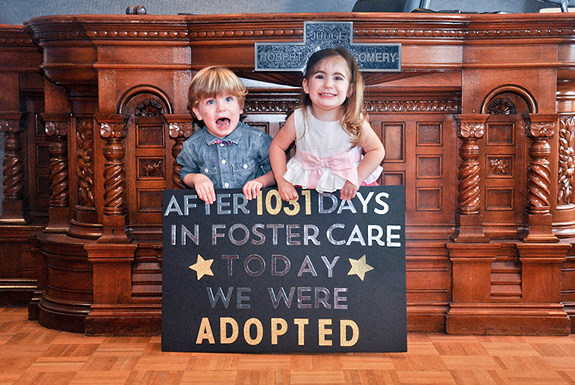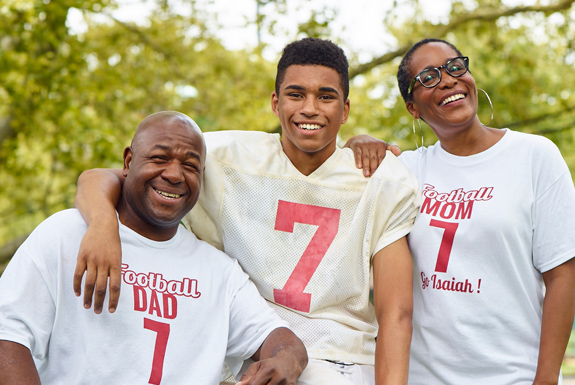Looking to Foster to Adopt a Baby Boy

Adopting a child from foster care is a great way to help a child while growing your family. Today there are more than 117,000 children and teens in foster care who are waiting for the love and security that a permanent home provides.
You can learn more about foster care and adoption by clicking through our short, interactive modules about the children in care and the families they need.
Children in foster care
Children enter foster care through no fault of their own, because they have been abused, neglected, or abandoned. These children are in the temporary custody of the state while their birth parents are given the opportunity to complete services that will allow the children to be returned to them if it is in the children's best interest.
Just more than half of children who go into foster care return to their birth families. For children who become available for adoption, many are adopted by a relative or their foster parents.
Adopting from foster care
Adopting from foster care is similar to other types of adoption in that after all of the decision making, paperwork, and preparation are completed, a dream of family is fulfilled. But foster care adoptions are different in a few important ways:
- Though it is possible to adopt a baby from foster care, the children who are available for adoption generally range from toddler to 21. The median age is eight years old.
- Because all children in foster care have experienced some form of trauma, parents who adopt from foster care undergo specific training to understand the effects of trauma and help children heal.
- Parents who adopt from foster care usually work with a public agency or a private agency that has contracted with the state to provide services.
- Adopting from foster care costs little to no money.
Read more about the different types of adoptions in Adoption Options: Where Do I Start? (321 KB PDF) on the Child Welfare Information Gateway website and "Caseworkers Weigh In: Advice to Prospective Parents," an article on our blog.

Fostering before adopting
An increasing number of states view foster care and adoption as a continuum and are establishing policies that encourage parents who are considering adoption to be foster parents first. For example, some states require that families seeking to adopt also take foster parent training and get approved to foster.
Fostering a child before adopting them has several benefits.
- Parents who are yearning to share their love and knowledge with children or youth can begin parenting sooner, while waiting for or identifying a match.
- Parents and the children placed in their care get a chance to assess whether they could have a permanent attachment to each other.
- Families can experience parenting children of wide range of ages—from infant to 21.
- Children make fewer moves.
- A child can live with her future adoptive parents, if the parents are also licensed to provide foster care, potentially reducing the amount of time parents must wait before an adoption is finalized.
- The family begins to bond.
- Parents gain experience parenting—and especially parenting children who have experienced trauma.
- Parents understand children's needs and can more accurately negotiate adoption assistance.
- Foster parenting demonstrates a prospective adoptive family's suitability for an adoptive placement.
- Foster parents are able to establish relationships with children's family members that could be sustained after the child is adopted.
An important aspect of fostering, even while the foster family is being considered to adopt the child in their care, is that foster parents must actively support efforts to reunify children with their birth parents so long as reunification remains the child's permanency plan, as determined by a court and public agency that are responsible for their custody and planning.
Foster parents must always be prepared for the very real possibility that children they hoped to adopt are returned to their birth parents or placed with other relatives, although that determination will nearly always be made prior to designation by the court of the placement as adoption. This dual role for foster parents is part of what is sometimes referred to as "concurrent planning," meaning that while a plan to reunify children with their parents is being actively pursued, work is also being done to quickly achieve an alternate permanency plan—often adoption by the foster parents—should the reunification plan not be successful.
Frequently asked questions
AdoptUSKids foster care and adoption resource specialists respond to hundreds of questions about foster care and adoption, and an active community of families is always exchanging information on our Facebook page.
Below are our responses to some of the more frequently asked questions we receive about adoption and foster care.
If I am only interested in adopting, why should I also get approved to foster?
There are several compelling reasons.
- Your state may require that you do. This is referred to as being "dual licensed."
- Even if your state allows parents to be approved to only adopt to begin the process, it will almost invariably require you to be approved to foster before a child is physically placed in your home for the purpose of adoption. Being approved as a foster parent when you are matched with a child will allow you to avoid the needless delay of completing additional paperwork and processes before the child can be placed into your home.
- Being dual licensed can potentially make your family a more desirable placement, especially when you are applying to adopt a child from another state. This is because the placement of a child can be made more quickly if you have already completed the additional paperwork and approvals to foster.
- A child placed with you will continue to receive financial support to help meet their needs. You will avoid a potential disruption in assistance that could occur while you become licensed to foster and before you can access any post-adoption financial support that might be available.
If my intent is only to adopt, but I am approved to both foster and adopt, will I be required to foster a child who may be reunified with their parents?
No. It is not in the best interests of you or the child for a social worker to make a placement that is not agreed upon in advance.
There are, however, at least a couple of situations in which your caseworker may ask you to consider accepting placement of a child as their foster parent. Having an open relationship with your worker will help you to understand such requests and empower you to make decisions that are best for your family and for the child.
- You may be asked to consider taking placement of a child on what is referred to as a "legal-risk basis." This can occur when the rights of one of a child's parents have been terminated, and the agency has a high degree of certainty that the rights of the other parent will be terminated. Having already been approved to foster will help this placement occur more smoothly and quickly.
- If your family does not have a lot of parenting experience, your social worker may recommend that you consider fostering so that you better understand the challenges and rewards of parenting a child who has experienced trauma.
What is involved in adopting children from another state?
Adoptions across state lines are governed by the Interstate Compact on the Placement of Children (ICPC). This agreement, between all 50 states, Puerto Rico, and the US Virgin Islands, ensures that children placed across state lines will be placed in safe, suitable environments and with people who are qualified to care for them.
Interstate adoptions require additional processes and paperwork, as well as increased communication between court and child welfare systems across state lines. A new electronic data exchange system launched in 2013, referred to as NEICE (National Electronic Interstate Compact Enterprise), is shortening the time it takes to place children across state lines. Read more about NEICE and about ICPC at the website of the Association of Administrators of the Interstate Compact on the Placement of Children.
While there are additional steps to work through, families can and do adopt children across state lines. You can read some of their stories on our blog.
What kind of support is available to families?
Financial assistance is available to cover all or most of the costs of adopting children from foster care and to fund their medical and mental health needs. Respite care—temporary child care that gives parents a needed break and time to meet other obligations—and local and online support groups are other ways that parents access help. Read more about support for foster parents and support for adoptive parents.
Can you provide information about international adoption?
AdoptUSKids exists and is funded to support adoption of children from US foster care. If you are interested in pursing an international adoption, we recommend you visit the US Department of State's Intercountry Adoption website.
Things to do next:
- Read about getting started to become a foster or adoptive parent.
- Request to be contacted by your state by completing this form or talking with one of our foster care and adoption specialists by calling 888-200-4005. They are ready to answer your questions and connect you with your local agency.
- Subscribe to receive updates from AdoptUSKids and our monthly newsletter for families, which includes profiles of children, featured family stories, and recent news related to adoption and foster care.
Looking to Foster to Adopt a Baby Boy
Source: https://www.adoptuskids.org/adoption-and-foster-care/overview/adoption-from-foster-care
0 Response to "Looking to Foster to Adopt a Baby Boy"
Post a Comment